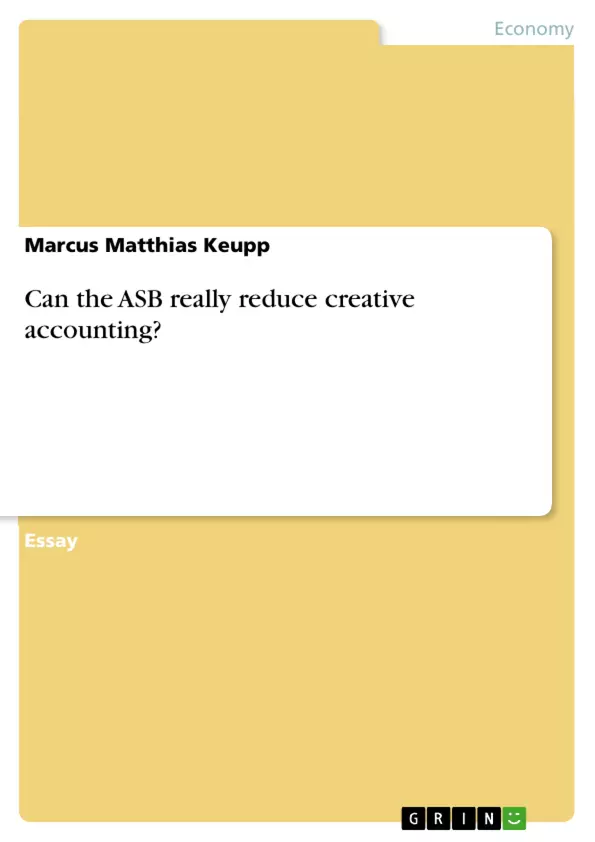The spectacular breakdown of Polly Peck impressively demonstrated the role of creative accounting in the 1980s. Although many companies were not doing well, creative accountants could easily deceive shareholders by manipulating figures.
The Companies Act requires financial statements ′to give a true and fair′ (i.e., factual and unbiased) ′view′. This enables user groups to properly assess a company′s financial position. If, however, accountants are free to arbitrarily manipulate figures, this becomes impossible. Therefore efforts had to be made to confine the extent of creative accounting.
By defining creative accounting (section 2), a critical evaluation of measures (section 3) and the conclusion (section 4), this essay will show that the measures introduced by the ASB are powerful to contain present creative accounting. However, they will not prevent future creative accounting.
Inhaltsverzeichnis (Table of Contents)
- Introduction
- Definitions
- Creative Accounting
- The ASB
- Critical Evaluation
- Off-balance sheet finance
- Quasi-subsidiaries and ‘lease and saleback' schemes
- FRS 5
- Reserve Accounting
- Exceptional Items
- FRS 3
- Off-balance sheet finance
- Conclusion
Zielsetzung und Themenschwerpunkte (Objectives and Key Themes)
This essay aims to evaluate the effectiveness of measures introduced by the ASB in reducing creative accounting practices. It examines the definition of creative accounting and critically analyzes the impact of specific standards on off-balance sheet finance and reserve accounting.
- Definition and scope of creative accounting
- The role of the Accounting Standards Board (ASB) in regulating financial reporting
- Effectiveness of ASB measures in preventing off-balance sheet finance schemes
- Impact of ASB standards on reserve accounting practices
- Limitations of current regulations in preventing future creative accounting
Zusammenfassung der Kapitel (Chapter Summaries)
The introduction highlights the need for accounting regulations to ensure transparency and prevent manipulation of financial figures, using the Polly Peck case as an example. It introduces the essay's structure, focusing on the definition of creative accounting, a critical evaluation of ASB measures, and a concluding assessment.
The "Definitions" section provides a clear definition of creative accounting, emphasizing its focus on legal compliance while deviating from the spirit of the law. It also defines the Accounting Standards Board (ASB) as the standard-setting body for UK accounting principles.
The "Critical Evaluation" section examines various ASB measures aimed at curbing creative accounting. It explores off-balance sheet finance schemes and the introduction of FRS 5, which aims to address the substance over form principle. This section also discusses reserve accounting, highlighting the changes introduced by FRS 3 in defining exceptional items and regulating their treatment in the profit and loss account.
Schlüsselwörter (Keywords)
The key themes and topics explored in this essay include creative accounting, off-balance sheet finance, reserve accounting, Accounting Standards Board (ASB), financial reporting, transparency, and regulatory effectiveness.
- Arbeit zitieren
- Marcus Matthias Keupp (Autor:in), 2001, Can the ASB really reduce creative accounting?, München, GRIN Verlag, https://www.grin.com/document/7763



